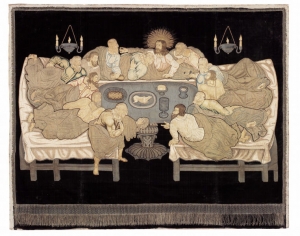The dossals are often decorated in the same manner as the frontal (appliqué, embroidery or woven forms). The first written reference to a dossal in English dates to AD 1658. Over time, the word has acquired the meaning of an ornamental cloth that forms the cover for the back of a chair or a seat, as well as the ecclesiastical meaning of an altar textile. During the twentieth century, the term dossal was also used to describe an ornamental cloth hung at the sides of a chancel.
See also: altar cover; lectern fall.
V&A online catalogue (retrieved 22 June 2016).
Source: Shorter Oxford English Dictionary: 'Dossel'
GVE

